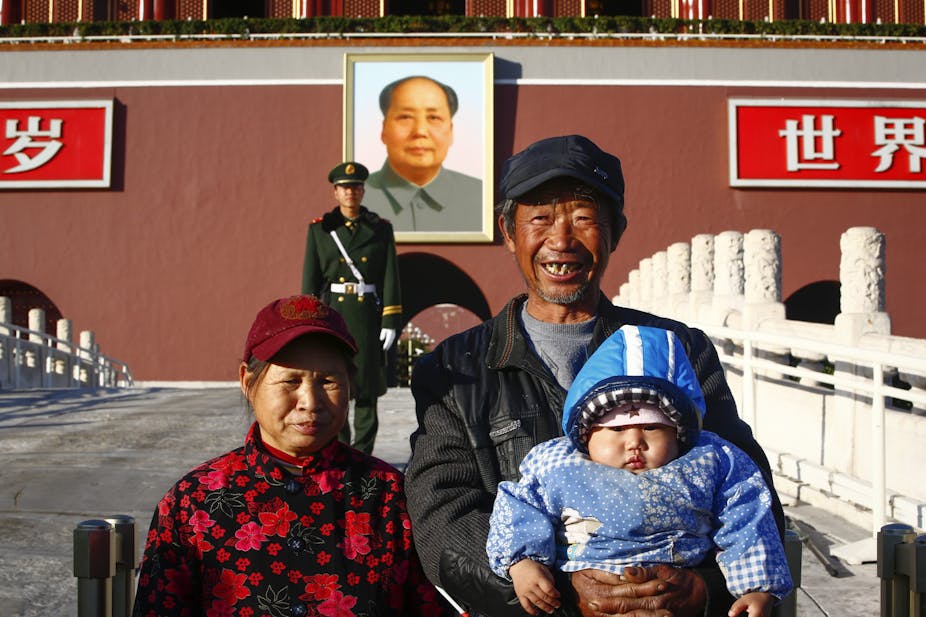The recent announcement that China’s one-child policy will be partially relaxed will be celebrated worldwide by libertarians, human rights activists and, most importantly, Chinese couples who have longed for larger families but dared not to face the consequences of doing so until now.
The shift in position from the Chinese government will allow urban couples to have two children if either the husband or wife is an only child. Many people will be hoping that the relaxation will go a step further by allowing all couples to have two children, or even by removing all state limits on family size some time soon.
Before joining this chorus of campaigners – who are almost certain to be disappointed – it may be worth reflecting first on some of the many costs and benefits of fertility decline (and hence, of the one-child policy).
The idea that a slowdown in the rate of population growth provides a boost to per capita income growth dates back to Thomas Malthus’ An essay on the principle of population, first published in 1798. This “population pessimism” was taken up by a number of development economists in the late 1950s. They asserted that fertility reductions - and the lower population growth - would be good for economic development.
Or, in other words, they argued that rapid population growth was a bad thing.
Mao Zedong did not buy into this argument, but was rather a “population optimist” who believed that “the more people we have, the stronger we will be”. Despite Mao’s views, the first three decades of Communist Party rule saw rapid fertility decline in China – precipitated by improvements in healthcare, female education, life expectancy and infant mortality, rather than strict family planning policies.
However, China’s population still increased by 400 million between 1949 and 1976, the year of Mao’s death. A growing recognition of a pending “population problem” (even by Mao himself) led to the “later, longer, fewer” policy in 1970. This called for later marriages, longer spaces between births and fewer children, and later led to the introduction of the one-child policy in 1979.
The one-child policy has unquestionably caused fertility to decline more rapidly than it otherwise would have - with estimates of the number of “averted births” ranging from 250 to 400 million - and has therefore played a significant role in China’s demographic transition. As I discussed in a previous article, this transition may have delivered a substantial “demographic dividend” to the country, explaining up to one-quarter of its per capita GDP growth in the last three decades according to some estimates.
With that rapid GDP growth has come better nutrition, rising levels of education, longer life expectancies, and higher living standards for the vast majority of Chinese people. The one-child policy, however controversial, should be given some of the credit for these outcomes.
The possibility that many of those extra 400 million people - had they been born – may have joined the ranks of the 180 million Chinese people still living under US$1.25 today is also worth considering. So too are the challenges relating to environmental degradation and food security in the world’s most populous nation.

This is not to deny the substantial, and in many cases immeasurable, costs of the policy. Rapid fertility decline in the past has now placed China in the uniquely challenging position of “getting old before getting rich”. Aside from the obvious economic costs of having more dependents and fewer workers in the population, the policy places a huge burden on single Chinese children at the bottom of the resulting “4-2-1” family structure (four grandparents, two parents and one child).
Even more consequential is the dramatic rise in China’s sex ratio at birth, the costs of which will be borne by an estimated 30 million or more Chinese men who will be looking for a wife in 2030 but unable to find one. The one-child policy – in combination with a traditional preference for sons and widespread access to ultrasound technology to detect gender since the mid-1980s – is at least partly to blame.
Other significant emotional costs result from not being allowed to determine your family’s size, being coerced into terminating second pregnancies, or giving birth to a second child who is not allowed to enrol in school or to access the healthcare system. These are all costs that defy measurement by someone who has never suffered them.
As discussed in another recent article in The Conversation, the latest policy change is only likely to have a small impact on the actual number of births. This impact was estimated by demographer Wang Feng to be in the range of one to two million extra births on top of the 15 million or so children currently born each year.
However small, it should still be celebrated for the role it might play in reducing the costs of the one-child policy – past, present and future. But this does not amount to damning the one-child policy in its entirety. The issues are far too complex for that.

